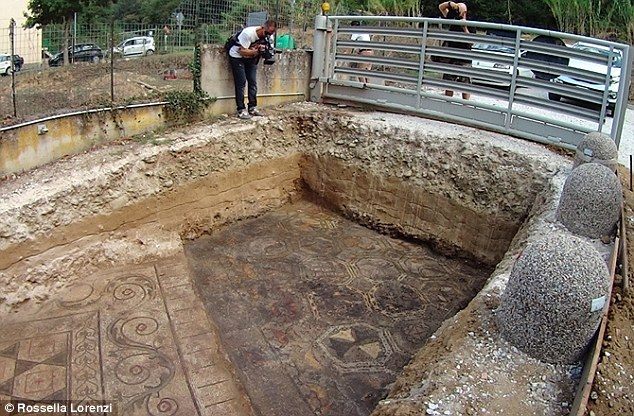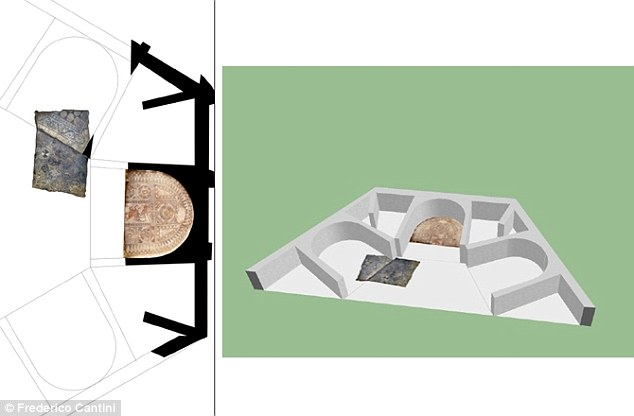Roman Empire buffs, listen up! In 2014, a new piece of an ongoing puzzle about Ancient Rome was discovered. This piece is part of a huge map carved on 150 marble slabs that is sized at a whopping 60 x 43 feet. This is not merely a random picture slab, this is a map of various parts of the city while Septimus Severus ruled. First discovered in 1562, “Forma Urbis Romae,” is made of thousands of marble fragments and this newest piece completes the words “Circus Flaminius.” The map has recently been used for a 3D reconstruction of Rome at its peak of glory, and now we can understand even more about Rome and its layout from a first-person perspective.
 You can read only around 10%, or 1,186 pieces, of the original map which hung on the Templum Pacis — also known as the Temple of Peace. Forma Urbis Romae was originally hung to the left of this church’s entrance. (Now these pieces are at Rome’s Capitolene Museum.) The newest piece was discovered while people were working at the Palazzo Maffei Marescotti, a building owned by the Vatican. It helps pull together a large textual puzzle that researchers are transcribing to understand more about Ancient Rome’s layout.
You can read only around 10%, or 1,186 pieces, of the original map which hung on the Templum Pacis — also known as the Temple of Peace. Forma Urbis Romae was originally hung to the left of this church’s entrance. (Now these pieces are at Rome’s Capitolene Museum.) The newest piece was discovered while people were working at the Palazzo Maffei Marescotti, a building owned by the Vatican. It helps pull together a large textual puzzle that researchers are transcribing to understand more about Ancient Rome’s layout.
The “Superintendency”, a spokesperson for the marble discovery, explains that of all the found pieces, only some have helped create the map’s topography:
“Of these about 200 marble chips have been identified and ideally located on the modern topography. The fragment relates to plate 31 of the map, which is the present-day area of the Ghetto, one of the monumental areas of the ancient city, dominated by the Circus Flaminius, built in 220 BC to host the Plebeian games, and where a number of important public monuments stood.”
With each new day we are learning more about a time and a civilization so far away. And then last month experts made a 3D reconstruction giving a rare glimpse into Rome at the height of its “greatness.” From a first-person perspective you can get a virtual tour through the city and visit famous sites that include the Colosseum and the Pantheon — as they would have looked around 320 AD. Using historic records to recreate forums and streets, academics have been able to provide a more holistic overview of not only what buildings existed but what may have been between the more famous building as well. The idea is: “Come through Rome with us, circa 320 AD!”
The video tour is a collaboration between Khan Academy, “virtual archaeologist” Dr. Bernard Frischer, and his project “Rome Reborn.” Rome Reborn is “an international initiative whose goal is the creation of 3D digital models illustrating the urban development of ancient Rome from the first settlement in the late Bronze Age (ca. 1000 B.C.) to the depopulation of the city in the early Middle Ages (ca. A.D. 550).” This tour shows the palaces Roman emperors enjoyed as they looked down on from Palatine (“palace”) Hill. Although only a small number of ruins and monuments can be seen today in Rome, the reconstruction flies low over a more completed terrain, showing the emperor’s hill and all the buildings below it.
is a collaboration between Khan Academy, “virtual archaeologist” Dr. Bernard Frischer, and his project “Rome Reborn.” Rome Reborn is “an international initiative whose goal is the creation of 3D digital models illustrating the urban development of ancient Rome from the first settlement in the late Bronze Age (ca. 1000 B.C.) to the depopulation of the city in the early Middle Ages (ca. A.D. 550).” This tour shows the palaces Roman emperors enjoyed as they looked down on from Palatine (“palace”) Hill. Although only a small number of ruins and monuments can be seen today in Rome, the reconstruction flies low over a more completed terrain, showing the emperor’s hill and all the buildings below it.
You can check out the video below and take a brief tour or this 3D reconstruction of Rome, which satisfies more of the curiosity driving the lengthy quest to learn all there is to learn about Ancient Rome — while also seeing 3D modeling and “virtual archaeology” at its finest! What do you think of these new techniques? Discuss in the Rome’s Reconstruction in 3D forum over at 3DPB.com.
Subscribe to Our Email Newsletter
Stay up-to-date on all the latest news from the 3D printing industry and receive information and offers from third party vendors.
You May Also Like
3D Printing Financials: voxeljet’s Financial Reshuffle
In a series of significant announcements made on March 13, 2024, voxeljet (Nasdaq: VJET) has revealed a plan to reshape its financial structure and strategic direction. As part of these...
Japanese Aerospace Leader Invests in 3DEO and Its Metal 3D Printing Tech
Los Angeles-based metal 3D printing startup 3DEO has announced a key investment from IHI Aerospace Co., Ltd. (IA), a subsidiary of Japanese manufacturing leader IHI. This collaboration marks a significant...
2025 Renault 5 E-Tech Electric Is Latest Car with 3D Printed Accessories
Due to the required numbers, additive manufacturing (AM) has struggled to make significant inroads into vehicle interiors in meaningful numbers—at least as far as public knowledge is concerned. Typically an...
Interview: NAGASE Facilitates AM Adoption with EMPOWR3D 3D Printing Brand
The additive manufacturing (AM) market is entering a new phase in which large companies from outside of the segment have entered and begun consolidating. In reality, this trend has been...

































